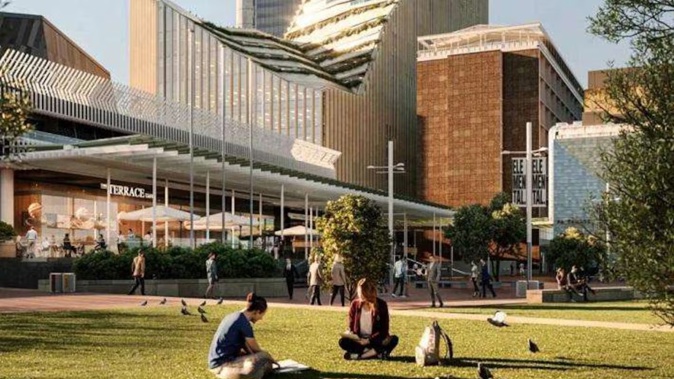
The Government and Auckland Council have reached an agreement to allow the upzoning of land close to City Rail Link stations.
The changes will mean greater housing density close to stations, allowing people to live within a shorter commuting distance of the CBD. Key stations of Maungawhau (Mount Eden), Kingsland and Morningside have now been specifically listed in the bill as requiring densification to be allowed around them.
The Government has given Auckland until October 10 to finalise a plan enabling the upzoning.
The Government has decided not to make the Medium-Density Residential Standards (MDRS) optional in centres outside of Auckland and Christchurch.
National campaigned on making the standard optional across the whole country and Act and National’s coalition agreement said the rules would become optional for councils, who would now be required “to ratify any use of MDRS, including existing zones”.
Housing Minister Chris Bishop, announcing the changes on Wednesday, said it “doesn’t make sense that we have single-storey houses on quarter-acre sections a stone’s throw away from stations that, in a year or so, will see trains every few minutes”.
The City Rail Link (CRL), one of the largest transport projects ever attempted in New Zealand, will open to passengers next year.
The project, which consists of a new double-tracked tunnel and stations, will provide capacity for 54,000 passengers per hour and is meant to double the number of Aucklanders who live within 30 minutes travel of the CBD.
“Successive Governments and councils have failed to grasp this opportunity for economic growth in New Zealand’s largest city. This is how modern, growing cities all around the world operate, and now it’s Auckland’s turn,” Bishop said.

Wayne Brown (from left), Chris Bishop and Simeon Brown. Photo / Brett Phibbs
- Auckland rail rebuild: Where it's happening, how long it'll take and how you'll be affected
- Derailed: Auckland trains won't be running for 96 days over coming 13 months
- KiwiRail promises to cut train delays in time for CRL opening
The announcement was made after a Resource Management Act amendment bill was reported back to the House by the Environment Committee.
The bill, once passed, will make a number of the changes announced on Wednesday and require the council to make other changes itself.
As part of the negotiations, Bishop allowed Auckland to opt-out of the Medium-Density Residential Standard (MDRS) – sometimes called the “sausage flat” law because it allowed many parts of cities to be zoned for the building of dense townhouses that were compared to sausages.
Auckland Minister Simeon Brown said the MDRS would be “abolished” in Auckland by the bill, which he described as a “common sense” compromise.
“Auckland must grow to fully meet its potential as a world-leading city. The one sized-fits-all approach of the MDRS was not appropriate for Auckland. Today’s announcement will ensure our city grows where it makes the most sense and maximise on the significant investment made in the City Rail Link,” Brown said.
Auckland Mayor Wayne Brown told the Herald the Government wanted more intensification “and we’re up for it – but in the right places”.
“We need more development along rapid transit corridors and where we have invested in significant infrastructure, while still protecting the quality of our urban areas.
“I’m keen to get on with preparing a replacement plan to give us the flexibility we need.“
MDRS mandatory for most councils
The MDRS resulted out of a compromise between the Dame Jacinda Ardern-led Government and the Judith Collins-led National Party.
It was intended to quickly and easily enable far more housing to be built on urban land, allowing people to subdivide sections and build up.
The changes, announced in 2021, led to some controversy. Some councils argued they were blunt and did not take adequate account of the infrastructure needed to service the new houses.
Post-flooding Auckland became concerned about building more housing on bad land.
National eventually U-turned on its support, saying councils would be allowed to opt out of the MDRS if they agreed to immediately zone for 30 years of housing growth.
The Government has watered this down, saying most councils have already grappled with the MDRS.
“Councils have been going through plan changes for years in order to incorporate the MDRS. Most councils have already substantially completed their plan changes through this process, with just three (Auckland, Christchurch and Waimakariri) yet to finish,” Bishop said.
He said opting out would require councils to change their plans again, “due to the length of time this typically takes under the RMA [Resource Management Act], by the time this was complete, the Government’s new planning system is expected to be in place”.
“Fundamentally, it would have achieved nothing, but cost ratepayers a lot.
“The Government has therefore taken the pragmatic view that it would be sensible to remove the ability for councils to opt out of the MDRS and to work on bespoke legislative solutions for Auckland and Christchurch instead,” Bishop said.
Plan change for Auckland
Auckland Council has been working on an intensification plan change since 2022, known as Plan Change 78 or PC78.
The challenge for Auckland is that the plan only allows upzoning, not downzoning. The council wants to downzone parts of the city that are known to prone to flooding and other natural hazards.
The council met a request from the Government to progress upzoning the central city by the end of May, finalising this part of PC78 on May 22, 2025.
The bill that has returned from the committee allows Auckland Council to remove parts of PC78, but requires the council to “process a new plan change urgently”.
This new plan cannot allow less housing than PC78.
The bill also lists three CRL stations, Maungawhau (Mount Eden), Kingsland, and Morningside and tells the council it must amend the Unitary Plan to allow for greater “demand for housing and business use in those locations”.
The bill says the council must zone for a level of housing and business use appropriate for the new stations and that in all cases the council must allow “building heights of at least six storeys in those locations”.
“Auckland Council must enable within a walkable distance from these stations heights and densities reflective of the higher demand for housing and business in these areas.
“This requirement goes further than the existing requirements under the NPS-UD and I expect heights and densities that ensure we make the most of the opportunities offered by this transformational transport project,” Bishop said, referring to the National Policy Statement for Urban Development or NPS-UD, a landmark 2020 planning rule change that also allowed more density.
Christchurch
Bishop said Christchurch had also been given a bespoke solution, allowing it to withdraw some aspects of the MDRS plan change.
However, he said the council could only do this if it zoned “for 30 years of housing growth at the same time”.
“Assessment of that target will be made by me, based on advice from officials,” Bishop said.
Labour and Greens respond
Labour issued a dissenting view on the select committee report, although the party did not mention disagreement over the housing aspects of what the Government proposed.
The party’s criticism was mainly about freshwater.
The Green Party said that while it supported the Government’s decision to U-turn and keep the MDRS mandatory for most councils, the decision to carve out Auckland and Christchurch was the wrong one.
“It is our view, that providing for the optionality of the MDRS for Auckland Council and Christchurch City Council is a missed opportunity for growth,” the Greens said.
“As an example, Cabinet’s decision to remove the backstop against the MDRS changes to only require councils to provide for 30 years of growth will effectively halve Auckland Council’s development capacity.”
Take your Radio, Podcasts and Music with you









